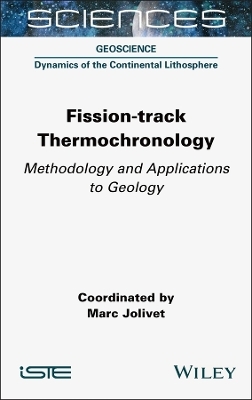
Fission-track Thermochronology
Iste Ltd (Verlag)
9781789451733 (ISBN)
After a brief history covering the discovery of fission tracks to their first applications in geochronology, Fission-track Thermochronology presents a complete description of not only the fission-track, but also the (U Th Sm)/He thermochronology approaches, both on basement rocks and on sediments. Firstly, the physical and chemical processes that underlie these techniques are addressed, and the analytical methods are described in detail. A particular focus is placed on the latest developments, such as the use of laser-ablation ICP-MS, and a whole chapter is dedicated to statistical modeling of the data.
Finally, numerous examples of applications to geological questions will provide the reader with a comprehensive overview of the possibilities of low temperature thermochronology in solving geological and geomorphological questions.
Marc Jolivet is a researcher at Centre National de la Recherche Scientifique, France, and is a geomorphologist interested in the long-term evolution of continental landscapes. He uses fissiontrack thermochronology to quantify vertical movements and erosion rates with a special interest in flat intracontinental surfaces.
Introduction
Marc JOLIVET
Chapter 1 Introduction to Detrital Apatite and Zircon Fission-track Thermochronology 1
Matthias BERNET
1.1 Introduction 1
1.2 Principals of fission-track dating 4
1.2.1. Basics of single grain apatite and zircon fission-track analysis 4
1.2.2 Closure temperature concept 6
1.2.3 Partial annealing zone concept 9
1.3 Sample preparation and fission-track dating 12
1.3.1 Sample preparation 12
1.3.2 External detector method 20
1.3.3 Track lengths measurements and track lengths distributions 23
1.4 Statistics of fission-track dating 27
1.4.1 Age equation, pooled age, central age, χ2-test and age dispersion 27
1.5 Detrital thermochronology 32
1.5.1 Continuous and discrete mixtures of detrital cooling ages 32
1.5.2 Peak fitting and minimum age model 34
1.5.3 Recognizing partial and full annealing in detrital fission-track data sets 36
1.6 Applications of detrital thermochronology 40
1.6.1 Studying source-to-sink relationships 40
1.6.2 Exhumation studies 43
1.6.3 Thermal histories of sedimentary basins 47
1.7 Concluding remarks 49
1.8 References 49
Chapter 2 Thermal History Modeling for Thermochronology 63
Kerry GALLAGHER
2.1 Introduction 63
2.2 Modeling diffusion and annealing 66
2.2.1 Diffusion 66
2.2.2 Annealing 69
2.3 Thermal history modeling 71
2.3.1 Forward modeling: making predictions to compare to observations 71
2.3.2 Examples of forward modeling 73
2.3.3 Inverse modeling: using observations to infer the thermal history 78
2.3.4 Examples of inverse modeling 81
2.4 Summary 87
2.5 References 88
Chapter 3 LA-ICP-MS 238 U Determination for Fission-track Dating 93
Nathan COGNÉ
3.1 Introduction 93
3.2 Zeta approach for LA-ICPMS 97
3.3 Absolute versus relative determination of U concentration 98
3.3.1 Absolute determination 98
3.3.2 Relative determination 101
3.4 Statistical data processing 105
3.4.1 Data dispersion 106
3.4.2 Calculation of the 238U/ XX Ratio Error 107
3.4.3 The problem of zero track crystals 109
3.5 Sample preparation and data acquisition for LA-ICP-MS dating 109
3.5.1 Preparing the mounts 109
3.5.2 Crystal counting and coordinates 111
3.5.3 Laser analytical conditions 111
3.6 Comparison of EDM and LA-ICP-MS methods 112
3.6.1 Advantages of the LA-ICP-MS method 112
3.6.2 The problem of uranium zonation 113
3.6.3 Comparison of EDM and LA-ICP-MS methods 114
3.7 Conclusion 115
3.8 References 116
Chapter 4 (U-Th-(Sm))/He Thermochronometry and Chronometry: Principles, Applications and Limits 121
Cécile GAUTHERON, Stéphanie BRICHAU, Raphael PIK and Laurent TASSAN-GOT
4.1 Introduction 121
4.2 Principle of the (U-Th-(Sm))/He 122
4.2.1 4He production 122
4.2.2 Ejection, implantation and He loss correction 124
4.2.3 He diffusion 128
4.2.4 Helium closure temperature and partial retention zone 135
4.2.5 (U-Th-(Sm))/He methods 136
4.3 Analytical methods (U-Th-(Sm))/He and 4He/ 3He 138
4.3.1 Crystal sorting and selection 138
4.3.2 Analysis of 4He and 3He concentrations 142
4.3.3 Analysis of uranium, thorium and samarium concentrations 142
4.3.4 Reproducibility of (U-Th-(Sm))/He ages 142
4.3.5 Data inversion 143
4.4 (U-Th-(Sm))/He and 4He/ 3He methods on various minerals 143
4.4.1 Apatite 145
4.4.2 Zircon 150
4.4.3 Iron oxides and hydroxides (hematite, magnetite and goethite) 153
4.5 Examples of geological applications 154
4.5.1 Landform formation and evolution 156
4.5.2 Records of landform formation in fore-chain sedimentary basins 159
4.5.3 Long-term evolution of continental crust 160
4.5.4 Faults and tectonics 162
4.5.5 Early orogenesis and inversion of passive margins in the Pyrenees 166
4.6 Limitations 169
4.7 Acknowledgments 169
4.8 References 169
Chapter 5 Application of Low-Temperature Thermochronology to the Dating and Quantification of Tectonic Movements: The Example of Asia 187
Marc JOLIVET
5.1 Introduction 187
5.2 A few reminders of the principles of fission-track thermochronology 190
5.3 The contribution of fission tracks to understanding the India–Asia collision 192
5.3.1 Fission track ages in Asia and their relationship to landforms 192
5.3.2 The exhumation of Cenozoic chains 194
5.3.3 Areas with very low exhumation rates: the Mongolian and Siberian ranges 209
5.4 Conclusion 211
5.5 References 212
Conclusion 227
Marc JOLIVET
List of Authors 233
Index 235
| Erscheinungsdatum | 31.12.2024 |
|---|---|
| Reihe/Serie | ISTE Consignment |
| Verlagsort | London |
| Sprache | englisch |
| Themenwelt | Naturwissenschaften ► Geowissenschaften ► Geologie |
| Naturwissenschaften ► Physik / Astronomie ► Thermodynamik | |
| ISBN-13 | 9781789451733 / 9781789451733 |
| Zustand | Neuware |
| Informationen gemäß Produktsicherheitsverordnung (GPSR) | |
| Haben Sie eine Frage zum Produkt? |
aus dem Bereich


